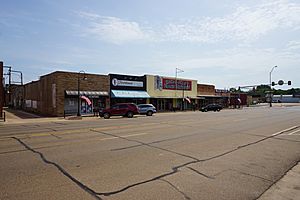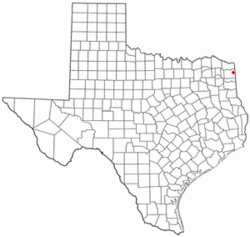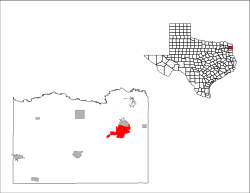Atlanta, Texas facts for kids
Quick facts for kids
Atlanta, Texas
|
|
|---|---|

E Main Street in Atlanta
|
|
| Motto(s):
One City Under God
|
|

Location of Atlanta, Texas
|
|
 |
|
| Country | United States |
| State | Texas |
| County | Cass |
| Government | |
| • Type | Strong City Manager form of Government, Home Rule Charter |
| Area | |
| • Total | 12.65 sq mi (32.77 km2) |
| • Land | 12.50 sq mi (32.37 km2) |
| • Water | 0.15 sq mi (0.39 km2) |
| Elevation | 256 ft (78 m) |
| Population
(2020)
|
|
| • Total | 5,433 |
| • Density | 429.49/sq mi (165.79/km2) |
| Time zone | UTC-6 (Central (CST)) |
| • Summer (DST) | UTC-5 (CDT) |
| ZIP code |
75551
|
| Area code(s) | 430, 903 |
| FIPS code | 48-04516 |
| GNIS feature ID | 2409749 |
Atlanta is a city in Cass County, located in the northeastern part of Texas, United States. It is known as "Hometown, USA". In 2020, about 5,433 people lived there.
Contents
Discovering Atlanta's History
Atlanta was started in 1872. This happened when the Texas and Pacific Railway was being built. The city was named after Atlanta, Georgia. Many of the first people who settled here came from that city. A post office opened in Atlanta, Texas, in the same year.
Early Growth and Industries
By 1885, about 1,500 people lived in Atlanta. They had built churches and schools. There was also a bank and many stores. A weekly newspaper called the Citizens' Journal was started. Lumbering was the main business at that time. Cutting down trees for wood was very important.
The lumber business was strongest around 1890. The city's population grew to 1,764 people. Atlanta became an official city in 1929. By then, it had 1,900 residents and 105 businesses.
Overcoming Challenges and Modern Times
In the 1930s, the Great Depression caused problems. Many businesses had to close. But in 1935, oil was found nearby. This helped Atlanta recover from the tough times. By 1940, the town had modern factories. These included canneries and lumber mills. The population grew to 2,453.
Atlanta continued to grow steadily. In the early 1960s, over 4,000 people lived there. By 1990, the population reached 6,118. Today, the main jobs in Atlanta include farming, forestry, oil, and tourism.
Exploring Atlanta's Geography
Atlanta is the biggest city in Cass County. It is located in the eastern part of the county. The city of Queen City is just north of Atlanta.
Major Roads and Connections
U.S. Route 59 goes around the west side of Atlanta. This road leads north to Texarkana, which is about 25 miles away. It also goes southwest to Linden, about 14 miles away.
Texas State Highway 77 runs through the southern part of Atlanta. It goes southeast to the Louisiana border, about 10 miles away. It also goes northwest to Dou Douglassville, about 13 miles away. Texas State Highway 43 passes through the center of Atlanta. It leads south to Marshall, which is about 47 miles away.
Climate in Atlanta
Atlanta has a climate with hot, humid summers. The winters are usually mild to cool. This type of weather is called a humid subtropical climate.
| Climate data for Atlanta, Texas (1991–2020 normals, extremes 1874–present) | |||||||||||||
|---|---|---|---|---|---|---|---|---|---|---|---|---|---|
| Month | Jan | Feb | Mar | Apr | May | Jun | Jul | Aug | Sep | Oct | Nov | Dec | Year |
| Record high °F (°C) | 85 (29) |
89 (32) |
92 (33) |
96 (36) |
102 (39) |
105 (41) |
108 (42) |
110 (43) |
109 (43) |
99 (37) |
88 (31) |
84 (29) |
110 (43) |
| Mean maximum °F (°C) | 76.4 (24.7) |
79.1 (26.2) |
84.6 (29.2) |
87.5 (30.8) |
92.4 (33.6) |
96.3 (35.7) |
100.2 (37.9) |
101.4 (38.6) |
98.0 (36.7) |
91.3 (32.9) |
82.8 (28.2) |
77.4 (25.2) |
102.6 (39.2) |
| Mean daily maximum °F (°C) | 56.2 (13.4) |
60.1 (15.6) |
68.7 (20.4) |
76.1 (24.5) |
83.2 (28.4) |
90.6 (32.6) |
94.4 (34.7) |
94.7 (34.8) |
88.4 (31.3) |
78.0 (25.6) |
66.2 (19.0) |
58.3 (14.6) |
76.2 (24.6) |
| Daily mean °F (°C) | 44.6 (7.0) |
48.3 (9.1) |
56.0 (13.3) |
63.4 (17.4) |
71.8 (22.1) |
79.6 (26.4) |
83.1 (28.4) |
82.9 (28.3) |
76.2 (24.6) |
65.0 (18.3) |
54.2 (12.3) |
47.0 (8.3) |
64.3 (18.0) |
| Mean daily minimum °F (°C) | 33.1 (0.6) |
36.5 (2.5) |
43.4 (6.3) |
50.6 (10.3) |
60.4 (15.8) |
68.6 (20.3) |
71.7 (22.1) |
71.0 (21.7) |
64.0 (17.8) |
52.0 (11.1) |
42.2 (5.7) |
35.7 (2.1) |
52.4 (11.4) |
| Mean minimum °F (°C) | 21.2 (−6.0) |
26.3 (−3.2) |
30.4 (−0.9) |
38.3 (3.5) |
49.6 (9.8) |
62.3 (16.8) |
68.0 (20.0) |
65.9 (18.8) |
54.3 (12.4) |
39.0 (3.9) |
28.8 (−1.8) |
24.3 (−4.3) |
19.5 (−6.9) |
| Record low °F (°C) | −2 (−19) |
−5 (−21) |
15 (−9) |
31 (−1) |
39 (4) |
52 (11) |
58 (14) |
53 (12) |
42 (6) |
28 (−2) |
16 (−9) |
5 (−15) |
−5 (−21) |
| Average precipitation inches (mm) | 4.12 (105) |
4.67 (119) |
4.51 (115) |
4.46 (113) |
5.17 (131) |
3.86 (98) |
3.29 (84) |
3.10 (79) |
3.86 (98) |
4.42 (112) |
4.06 (103) |
4.76 (121) |
50.28 (1,278) |
| Average snowfall inches (cm) | 0.2 (0.51) |
0.6 (1.5) |
0.1 (0.25) |
0.0 (0.0) |
0.0 (0.0) |
0.0 (0.0) |
0.0 (0.0) |
0.0 (0.0) |
0.0 (0.0) |
0.0 (0.0) |
0.0 (0.0) |
0.0 (0.0) |
0.9 (2.26) |
| Average precipitation days (≥ 0.01 in) | 7.8 | 8.7 | 9.1 | 8.6 | 7.9 | 7.0 | 6.6 | 6.1 | 5.7 | 6.9 | 7.6 | 8.2 | 90.2 |
| Average snowy days (≥ 0.1 in) | 0.1 | 0.3 | 0.1 | 0.0 | 0.0 | 0.0 | 0.0 | 0.0 | 0.0 | 0.0 | 0.0 | 0.0 | 0.5 |
| Source 1: NOAA | |||||||||||||
| Source 2: National Weather Service | |||||||||||||
Understanding Atlanta's Population
| Historical population | |||
|---|---|---|---|
| Census | Pop. | %± | |
| 1880 | 396 | — | |
| 1890 | 1,764 | 345.5% | |
| 1900 | 1,301 | −26.2% | |
| 1910 | 1,604 | 23.3% | |
| 1920 | 1,469 | −8.4% | |
| 1930 | 1,685 | 14.7% | |
| 1940 | 2,453 | 45.6% | |
| 1950 | 3,782 | 54.2% | |
| 1960 | 4,076 | 7.8% | |
| 1970 | 5,007 | 22.8% | |
| 1980 | 6,272 | 25.3% | |
| 1990 | 6,118 | −2.5% | |
| 2000 | 5,745 | −6.1% | |
| 2010 | 5,675 | −1.2% | |
| 2020 | 5,433 | −4.3% | |
| U.S. Decennial Census | |||
| Race | Number | Percentage |
|---|---|---|
| White (NH) | 3,277 | 60.32% |
| Black or African American (NH) | 1,602 | 29.49% |
| Native American or Alaska Native (NH) | 17 | 0.31% |
| Asian (NH) | 33 | 0.61% |
| Pacific Islander (NH) | 3 | 0.06% |
| Some Other Race (NH) | 26 | 0.48% |
| Mixed/Multi-Racial (NH) | 187 | 3.44% |
| Hispanic or Latino | 288 | 5.3% |
| Total | 5,433 |
In 2020, Atlanta had 5,433 people. There were 2,118 households and 1,466 families living in the city.
In 2010, the city had 5,745 people. There were 2,254 households. About 32.9% of households had children under 18. Many households were married couples. Others were single-parent families or people living alone.
The average age in Atlanta was 37 years old. About 27% of the population was under 18. About 19% of the population was 65 or older.
Education in Atlanta
Most students in Atlanta attend schools in the Atlanta Independent School District. This district includes Atlanta High School. Some students go to the Queen City Independent School District. This district operates Queen City High School.
For higher education, Atlanta is served by Texarkana College. This college helps students from most of Cass County. Texas A&M-Texarkana is also in the area.
Notable People from Atlanta
Many interesting people have connections to Atlanta:
- Derrick Blaylock – a football player for the Kansas City Chiefs
- Tony Buzbee – a well-known Texas attorney
- Susanna Clark – an artist and songwriter, born in Atlanta
- Bessie Coleman – a famous civil aviator (pilot)
- Ellen DeGeneres – a popular talk show host and comedian
- Phil Epps – a former American football player
- Tracy Lawrence – a country music singer
- Andrea Lee – an American kickboxer and mixed martial artist
- Gordon McLendon – a pioneer in American radio broadcasting
- Slim Richey – a musician, born in Atlanta
- Max Sandlin – a former Democratic Congressman
- Joseph Strickland – a former Roman Catholic bishop
- Drew Stubbs – a baseball player
- Nat Stuckey – an American country singer
- Ted Thompson – a former general manager for the Green Bay Packers
See also
 In Spanish: Atlanta (Texas) para niños
In Spanish: Atlanta (Texas) para niños

